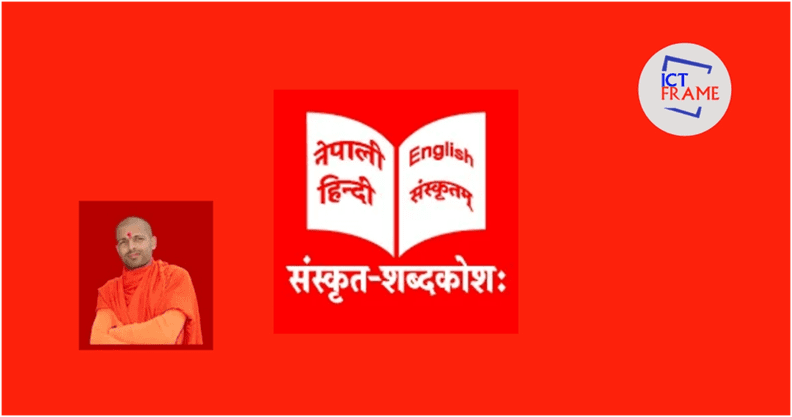Sanskrit Dictionary Launched: Easy Translation For 4 Languages
21 November 2020, Kathmandu
Swami Keshavananda Giri has launched the world’s largest Sanskrit-Nepali-English-Hindi dictionary. This electronic Sanskrit dictionary lets you know the meaning of words in all four languages (Sanskrit, Hindi, Nepali and English). Work on the dictionary was started last year under the leadership of Swami Keshavananda Giri himself. The dictionary contains the meanings of four million words in all four languages. As for now the dictionary is only available for Android on Google Play Store. Similarly, by visiting KN Swami‘s website, words and their meanings can also be searched. So, to find words in these four languages both app and website can be used.
Giri, who is doing PhD from Sanskrit University on ‘Adini Philosophy in Panini’s Ashtadhyayi’, aims to create a comfortable environment for students and researchers by connecting Eastern literature with technology.
Key Features of Sanskrit dictionary
Searching for a word in it will reveal its meaning in all four languages. The dictionary contains
- One lakh words from Sanskrit to Nepali
- One and a half lakh words from Sanskrit to Sanskrit
- 50 thousand words from Sanskrit to Hindi
- 50 thousand words from Sanskrit to English.
So if you are looking for sanskrit translation along with it’s meaning then this app will be very useful for you
Compatibility
- This dictionary mobile app is compatible to later versions of Android Five.
- The size of the mobile app is only 126 MB.
This dictionary will also be useful for knowing about 75 percent of the Sanskrit words used in Nepali. By combining Eastern literature with technology, he has made it easy for curious people to study and research. Also KN Swami has prepared the Unicode font for Vajasaneyi-Madhyandin-Shuklayajurveda-Samhita and edited it. Giri did this so that the students would not have to go through the experience of having difficulty in getting the textbooks while studying in the gurukul.
Who can use Sanskrit Dictionary?
As Swami Keshavananda got free education in the Gurukul. This dictionary app which was prepared at a cost of around Rs 5 million is available to the users for free of cost.
This electronic dictionary doesn’t contain any kind of ads. If advertisement is placed then searcher’s attention might divert to the advertisement. So, the dictionary is ad-free. During the six months of the lockdown, Giri and six of his disciples worked from 5 am to 11 pm to compile the dictionary.
This dictionary will be useful for those who want to know the meaning of Sanskrit words, students of Sanskrit and for various study and research. This dictionary will also be important material for the study of inscriptions, ancient records and other materials.
Electronic version of ancient dictionaries
The two Sanskrit dictionaries ‘Shabdakalpadrum’ and ‘Vachaspatyam” , are electrponically available in the app. Vachaspati Bhattacharya prepared Vachaspatyam, a dictionary in 1870. Similarly, King Radhakanta Dev prepared Shabdakalpadrum in 1859. All the words in both the cells are kept electronically. Also, all the words of Vaman Shivaram Apte’s Sanskrit-Hindi dictionary published in 1966 and Sanskrit-English dictionary published in 1890, stored electronically.
Various other dictionaries are available in the electronic medium such as Comprehensive Nepali-Sanskrit Dictionary published by Nepal Sanskrit University, Sanskrit-Nepali Dictionary of Kul Chandra Gautam, Sanskrit-Kannada Dictionary, Sanskrit-English Dictionary of Munier Nilims . Similarly, it contains all the words of the Nepali Comprehensive Dictionary published by Nepal Pragya Pratisthan. Keshavananda himself translated the origin of the metal.
In this dictionary includes meanings of Etymology and metallic. Similarly, users can find the meaning of prefixing metal. After some time there will be addition of forms of metal.
KN Swami said that this dictionary is the first to cover all the topics mentioned above.







